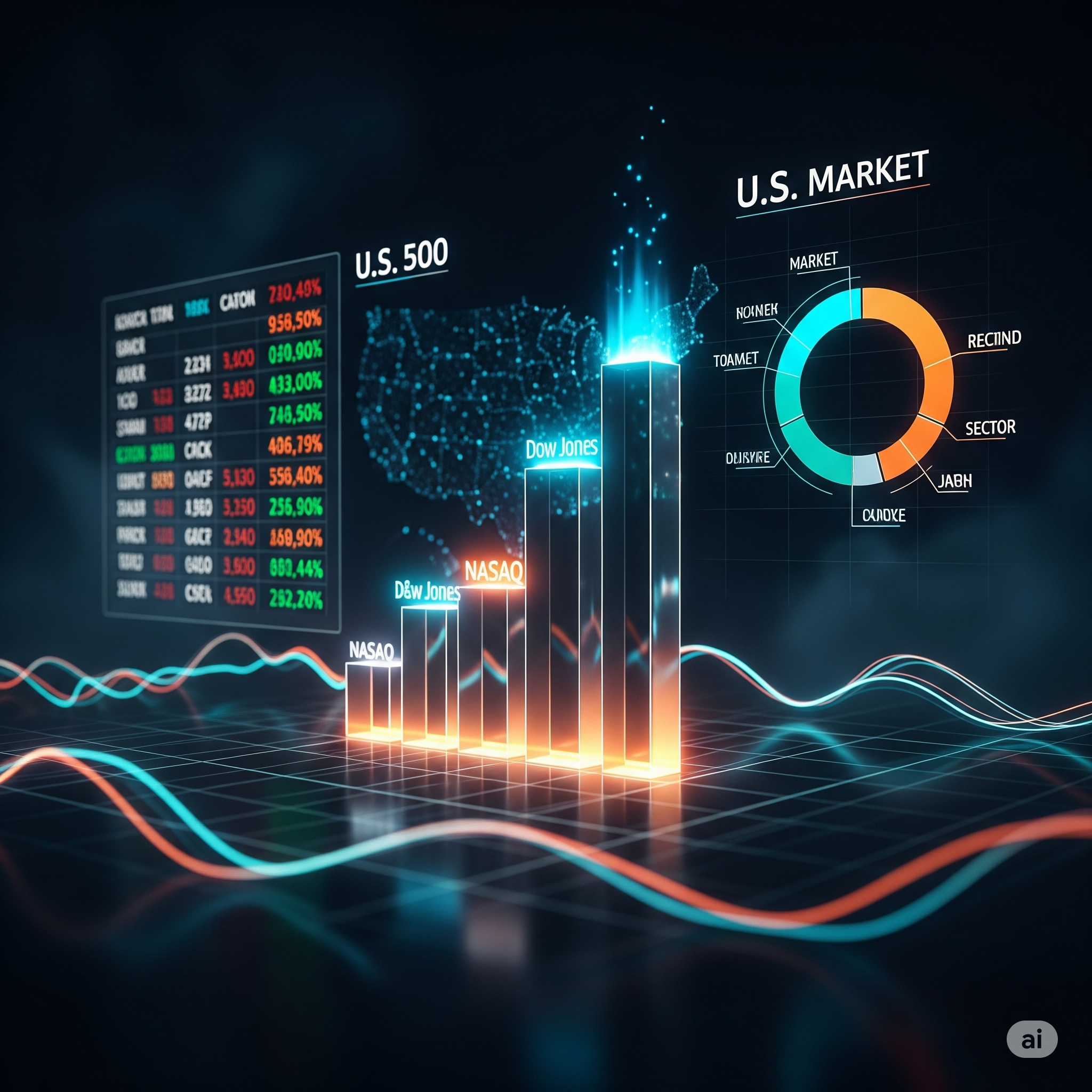Introduction
The United States has long been recognized as the world’s largest and most influential economy, with deep financial markets, a diverse industrial base, and an innovative technology sector. Understanding the U.S. market is crucial for students, economists, investors, and policymakers, as developments in this market often set global economic trends. The U.S. market encompasses stock exchanges, bond markets, commodities, labor, technology, and consumer-driven sectors. This snapshot explores the structure, performance, trends, and challenges of the U.S. market in a comprehensive manner.
Structure of the U.S. Market
1. Equity Market
The U.S. equity market is dominated by major stock exchanges such as the New York Stock Exchange (NYSE) and NASDAQ. The market is home to some of the world’s largest companies, including Apple, Microsoft, Amazon, and Tesla. Equities are categorized by sectors such as technology, finance, healthcare, energy, consumer goods, and industrials.
The U.S. stock market is often considered a barometer of economic health. Investors’ sentiment, corporate earnings, geopolitical events, and macroeconomic indicators such as GDP and unemployment rates directly influence stock prices. Market capitalization of U.S. equities exceeds $50 trillion, making it the largest globally.
2. Bond Market
The U.S. bond market is the world’s largest fixed-income market, encompassing government securities, municipal bonds, and corporate debt. Treasury securities, issued by the federal government, are considered nearly risk-free and serve as a benchmark for interest rates globally. Corporate bonds provide businesses with capital to expand operations, fund research, or refinance debt.
Bond market movements are influenced by interest rates, inflation expectations, credit ratings, and fiscal policies. Investors often use bonds to hedge against stock market volatility, making them an integral part of the U.S. financial system.
3. Commodity Market
The U.S. commodity market includes energy products, metals, agricultural goods, and derivatives. Major commodities include crude oil, natural gas, gold, silver, corn, soybeans, and wheat. The Chicago Mercantile Exchange (CME) and New York Mercantile Exchange (NYMEX) play a key role in global commodity trading.
Energy commodities like oil and natural gas significantly affect domestic production costs, inflation, and international trade. Agricultural commodities, particularly corn and soy, reflect both domestic policy and global demand.
Key Sectors of the U.S. Market
1. Technology Sector
Technology drives U.S. market performance, innovation, and global influence. Companies such as Apple, Microsoft, Google, Amazon, and Meta dominate market capitalization. The technology sector encompasses software development, hardware manufacturing, e-commerce, artificial intelligence, and cloud computing.
Recent trends include investments in AI, robotics, cybersecurity, and semiconductor production. U.S. tech companies not only influence domestic markets but also shape global standards and trade dynamics.
2. Financial Services
The U.S. financial sector includes commercial banks, investment banks, insurance companies, asset managers, and fintech companies. Wall Street serves as the epicenter for capital allocation, trading, and risk management. Innovations in fintech and digital banking are expanding access to credit, investment, and payment services.
3. Healthcare and Pharmaceuticals
Healthcare and pharmaceutical industries contribute significantly to the U.S. market. Leading companies include Pfizer, Johnson & Johnson, and UnitedHealth Group. The sector covers medical devices, healthcare services, biotechnology, and pharmaceutical manufacturing. Research and development (R&D) investment in healthcare drives innovation but also raises questions about affordability and accessibility.
4. Energy Sector
Energy production, including oil, natural gas, and renewable energy, is a major component of the U.S. market. The U.S. is a global leader in shale oil and natural gas production. Renewable energy, including solar, wind, and biofuels, is increasingly important in reducing dependence on fossil fuels and achieving climate targets.
5. Consumer Goods and Retail
The U.S. consumer market is vast, representing more than 70% of GDP through consumption. Retail giants like Walmart, Amazon, and Costco dominate domestic sales, while small and medium enterprises contribute to local economic diversity. Trends in e-commerce, sustainability, and personalized marketing are shaping consumer behavior.
Current Trends in the U.S. Market
1. Stock Market Volatility
In recent years, volatility in U.S. equities has increased due to geopolitical tensions, interest rate fluctuations, inflationary pressures, and technological disruptions. The rise of retail investors and algorithmic trading also affects market behavior.
2. Interest Rates and Inflation
The Federal Reserve’s monetary policy, including interest rate adjustments and quantitative easing, directly influences bond yields, consumer loans, and corporate borrowing. Inflation has recently emerged as a significant concern, affecting purchasing power and corporate margins.
3. Technological Innovation and AI
Artificial intelligence, machine learning, blockchain, and cloud computing are reshaping the U.S. market. AI adoption in finance, healthcare, and logistics increases productivity but also raises concerns about employment displacement and regulatory oversight.
4. Global Supply Chain Challenges
Global disruptions, including the COVID-19 pandemic, Russia-Ukraine conflict, and trade restrictions with China, have affected supply chains for technology, automotive, and consumer goods sectors. Companies are exploring diversification, reshoring, and nearshoring to reduce vulnerabilities.
5. Sustainable Investing
Environmental, Social, and Governance (ESG) investing is gaining momentum in the U.S. market. Investors are increasingly evaluating companies on sustainability metrics, carbon footprint, and social responsibility, influencing corporate strategies and long-term growth.
Challenges Facing the U.S. Market
- Geopolitical Risks: Tensions with China, Russia, and other nations affect trade, supply chains, and investment flows.
- Income Inequality: Economic growth has not benefited all segments equally, contributing to social and political tensions.
- Regulatory Uncertainty: Policy shifts in taxation, antitrust regulations, and environmental compliance create challenges for businesses.
- Debt Levels: Both public and private debt are rising, increasing vulnerability to interest rate hikes and financial shocks.
- Labor Market Dynamics: Workforce shortages in technology, healthcare, and manufacturing sectors challenge productivity and growth.
U.S. Market Indicators
1. Gross Domestic Product (GDP)
GDP growth measures the overall health of the economy. The U.S. maintains steady growth, although it fluctuates with economic cycles. GDP trends reflect consumer spending, investment, government expenditure, and net exports.
2. Unemployment Rate
The labor market is a crucial indicator of economic stability. Unemployment affects consumer demand, income levels, and social stability. The U.S. has seen historically low unemployment post-pandemic, though certain sectors face labor shortages.
3. Consumer Price Index (CPI) and Inflation
CPI measures changes in the price of a basket of goods and services. Inflation affects purchasing power, investment decisions, and central bank policies. Recent inflationary pressures have prompted the Federal Reserve to adjust interest rates.
4. Stock Market Indices
Indices like the S&P 500, Dow Jones Industrial Average, and NASDAQ Composite provide insights into sectoral performance, investor sentiment, and market trends.
5. Bond Yields and Interest Rates
Treasury yields and corporate bond rates indicate borrowing costs, risk perception, and liquidity in financial markets.
The Role of the Federal Reserve
The Federal Reserve (Fed) plays a critical role in maintaining market stability. Its responsibilities include controlling inflation, managing interest rates, supervising banks, and ensuring financial system liquidity. Fed policies directly affect equity and bond markets, lending behavior, and economic growth. For example, during economic slowdowns, the Fed may lower interest rates to encourage borrowing and investment. Conversely, during inflationary periods, it raises rates to control price surges.
Future Outlook of the U.S. Market
The U.S. market is poised for both opportunities and challenges in the coming decades:
- Technological Leadership: Continued innovation in AI, biotech, renewable energy, and aerospace will drive growth.
- Global Trade Relations: Trade agreements and tensions will shape export and import dynamics, especially with Asia and Europe.
- Sustainability Focus: ESG-driven investments and green energy adoption will redefine sectors like energy, transportation, and manufacturing.
- Financial Market Evolution: Digital currencies, fintech innovations, and blockchain integration will reshape payments, investments, and banking systems.
- Demographic Shifts: Aging population, immigration trends, and workforce evolution will influence labor markets and consumption patterns.
Conclusion
The U.S. market remains a cornerstone of the global economy. Its diverse sectors, deep financial markets, and technological leadership make it a central hub for global investment and trade. Understanding the structure, trends, challenges, and indicators of the U.S. market is essential for students, policymakers, and investors. While challenges such as inflation, labor market shifts, and geopolitical tensions persist, the overall resilience and adaptability of the U.S. market ensure its continued influence on the global economic landscape.




